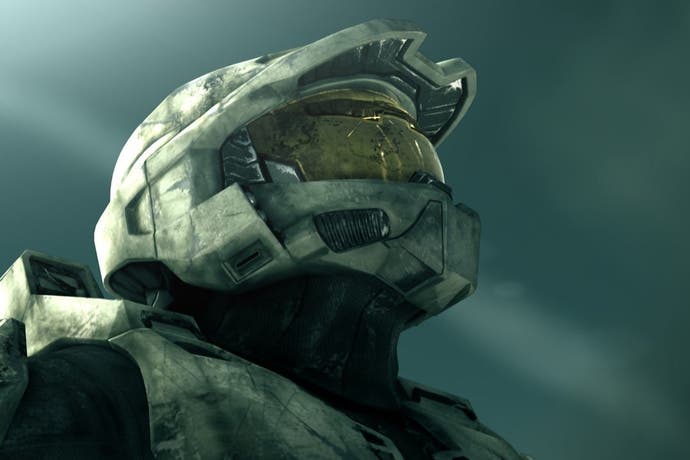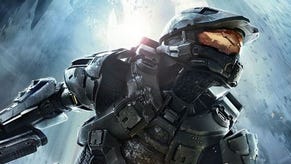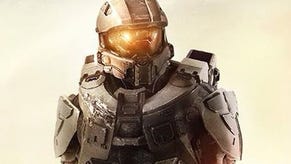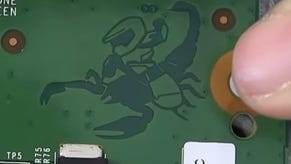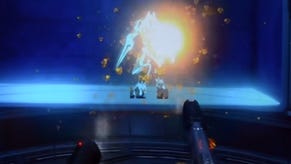Why I hope we never see Master Chief's face
Everyman for himself.
There's a moment during Halo 5's story campaign when developer 343 teases us. Master Chief, grizzled super soldier and veteran of countless battles, prepares to lead yet another crucial mission on yet another mysterious spaceship full of even more dangerous aliens. He sits in the cockpit of his dropship, iconic dark green space marine helmet in his hands, and stares. As he moves to put the helmet on, the camera pans in such a way as to ensure part of the dropship obscures his face. Then the helmet is on, the tease complete. Almost, but no cigar.
343 is having a bit of fun here, suggesting, perhaps, that Halo 5 may, finally, be the game in which Halo fans get to see Master Chief's face.
I hope it isn't. In fact, I hope Microsoft keeps Master Chief's face hidden forever.
It seems silly, really, that any video game would be this obsessed with keeping its protagonists' face a secret. It's just a video game, at the end of the day, about a super soldier killing hundreds of aliens and saving humanity. It's silly heroic science fiction, not War and Peace. And yet, I love it.
For years now, I've played and loved the Halo campaigns in part because I imagine myself in that suit. I imagine myself wearing that helmet, shooting those Grunts, sniping those Elites, and shotgunning all of the Flood until the entire lot of them are a messy goop on the shiny floor of some Forerunner installation. Master Chief is a faceless hero, but he's not, really, because his face is our face.
His heroism is our heroism. When that iconic dum dum dum duuum music ramps up and the black borders appear at the top and bottom of our screens, the hairs on the back of our necks rise to attention, saluting, proud of our past victories and excited about the upcoming battle.
It helps, of course, that Halo is a first-person shooter. As we look into the game worlds Bungie and 343 Industries have created for us, a heads-up display shows us how much ammo we have remaining, our grenade type and our targeting reticle. It looks and feels as if we're in the suit, we're wearing the helmet, and we're firing the gun.
If 343 were to show us Master Chief's face, this sense that we are all the hero of Halo would be diminished. One criticism often labeled at Halo is that Master Chief has all the personality of a black hole, that the few lines he delivers do little more than move the nonsensical plot along one inch at a time. Good. The less he speaks, the easier it is to imagine I'm doing the speaking. Chief never talks when the player is in control, when the player is in a firefight, when the player is shooting aliens. When one of Bungie's famous 30 seconds of fun ends and the action calms, Chief may say a word or two, perhaps to Cortana, perhaps to someone else. Then, when the action kicks off again, he shuts up, letting the player - and the assault rifle - do the talking. It comes as no surprise to learn that Master Chief voice actor Steve Downes based his personification of the Chief on a sketch that called for a Clint Eastwood-type character of few words.
There's also something of the Everyman about Master Chief. Master Chief's story begins when he, along with a number of other children, are, essentially, kidnapped. They're stolen away and turned into super soldiers, experimented on, altered. It's all pretty awful. Master Chief has a name and it is John - about as Everyman a name as you could want. His name is not Duke, or Dutch, or Conan, or any other character Arnie has played. It's John. Strong, but plain. He didn't ask to be the person charged with saving the world. He was just a normal kid, plucked from his bed in the middle of the night, forced to save our souls. It could have been anyone. It could have been one of us.
The funny thing is, we have an idea of what Master Chief looks like. In Eric Nylund's 2001 novel The Fall of Reach, the six-year-old John is described as "typical", with "tousled brown hair" and "a sly grin that revealed a gap between his front teeth". "A few freckles were speckled across his cheeks." That sounds like six-year-old me.
To coincide with the launch of Halo 5 this month, 343 will release an animated adaptation of The Fall of Reach. Its debut trailer, below, disappoints me because we see John's face as his origin story plays out. Now, I know we're not seeing Master Chief here, but still, the illusion is diminished, ever so slightly. If we see Master Chief as a young man, we can better imagine what he looks like as a grizzled old warrior. This, I do not want.
Perhaps Halo 5 creative director Tim Longo agrees with me. "There's a mystery and iconic nature to him as a character," he told me recently. "Once you take his helmet off, it's going to change what he is to people. Because right now you don't know. Maybe we'll never know."
It sounds like the issue of Master Chief's face is an important one for 343, too. "It is debated all the time, by the way, at the company," Longo said. "It comes up every month. Somebody's like, so when are we going to...?"
Never, I hope.
